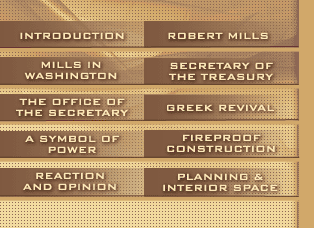|
The Treasury Building was “to bring honor and
benefit” to the nation, “to show to the
European… that the american [sic] talent for architecture
is not a whit inferior to the European’s.”
~Robert Mills
With its colossal colonnade, Treasury’s
stone exterior was a bold move toward creating a façade
unlike any other in Washington. Robert Mills’
design for the new Treasury bore little resemblance
to its brick-clad Georgian predecessor that was identical
to the State, War, and Navy Department buildings flanking
the east and west sides of the White House.

This photograph, taken between 1862-1866,
shows the stylistic contrast between the Greek Treasury
façade, seen at the left side of the photograph,
and the Georgian State Department Building, seen at
the right side of the photograph. The State Department
building was demolished in 1866 to allow for Treasury’s
North wing addition.
Click
here to see a more detailed image
By the early 1830’s, Treasury’s
distinctive uninterrupted colonnade appeared in only
a few buildings in America, never used before in federal
architecture in Washington. Mills cited the Bourse des
Valeurs, the 1808 Stock Exchange in Paris, as well as
the colonnaded addition to the eastern façade
of the Louvre as contemporary precedents that inspired
Treasury’s East façade, evidence of a shift
towards America’s increasing sophistication alongside
its economic progress.

Mills was not alone in
his admiration for the design for the Bourse des Valeurs
in Paris, seen left, which received much public praise
when it opened in 1808.
Treasury’s long colonnade is perched
high upon the ground story base that skims 15th Street,
creating a strong horizontal facade that Mills himself
considered “both grand and imposing”. The
thirty columns retain its repetitious impact, even after
the pediments at the North and South were added with
the later extensions to Treasury.

Photograph by Gary Griffen
The large size of Mills’ original plan
demonstrates the growth of the Treasury Department,
the government, and the expanding nation. Upon completion,
the Treasury was a robust symbol of America’s
increasing economic stature while serving as a catalyst
toward an aesthetic of austere formality of architecture
in Washington.

This 1869 engraving
shows the dominant size of the Treasury Building ,
seen in the center of the image, over the landscape
of Washington, reflecting the prominence of the national
treasury in the American government.
Drawn by Theo[dore] R. Davis. Kiplinger Collection.
Click
here to see a more detailed image
| 

